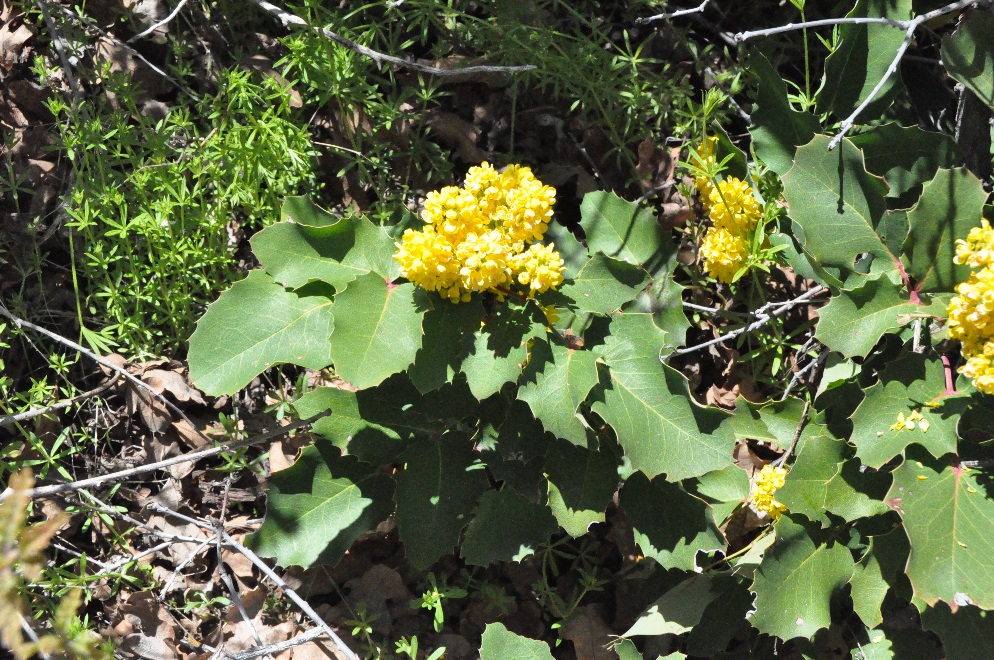Creeping Oregon Grape in the Landscape

Larry A. Rupp, Center for Water Efficient Landscaping, Utah State University
Scientfic Name: Berberis repens (Mahonia repens)Common Name: Creeping barberry, creeping Oregon grape
Description: Creeping Oregon grape is a perennial, woody groundcover. One of its most unique characteristics is that it is also a broad-leafed evergreen. The pinnate leaves are typically a dull, glaucous green which turns to various muted shades of purple in the fall, with occasional bright flashes of reds and/or oranges. The plant has a rhizomatous habit and is often spreading in both nature and in the landscape. In the spring of the year it has very attractive racemes of yellow flowers that give way to blue berries in a grape-like cluster, thus giving rise to at least one of the common names. The berries are quite persistent and add interest to the landscape well into the winter. Typically it is under 12-inches tall, but size can vary with the environment, especially in optimum landscape conditions. It commonly occurs as individual plants, but can also occur in patches of plants connected by stem tissue.
Native Habitat: Berberis repens occurs throughout western North America and is common in almost all Utah habitats above 3500 feet. It is very common in forested areas, but is also common in upland shrub or steppe regions and occurs at elevations up to 10000 feet. Creeping Oregon grape is adapted to a wide range of light conditions and can be found in full sun, partial, and full shade. It is a very common understory plant and thrives in partial shade. It is also tolerant to a wide range of soil textures and pH’s, though not wet or saline soils.
Cultural Requirement
Soil: Adapted to a wide diversity of soil textures, as long as they are well-drained. It is also adapted to alkaline, neutral, or acidic soils.
Moisture Tolerance: Once established plants can tolerate very dry conditions, though moisture availability will be reflected in plant size. Thrives in good soil with minimal or periodic irrigation.
Sun/Shade/Preference: Can tolerate full sun, but also does very well in partial shade and even heavy shade.
Transplanting: Easily transplanted as a container plant. Bareroot plants seem to be somewhat slow to establish.
Propagation: Creeping Oregon grape can propagate itself by seed, rhizomes, stolons, and stem layering. As a result, this plant can spread in the landscape, though not aggressively. Seeds require stratification and have relatively low germination of 20-25%. It can also be established by cuttings using rooting hormone treatments and intermittent mist. Cuttings have been successfully rooted when collected in late fall or early spring. The easiest method of propagation for gardeners would be to dig and divide rooted rhizomes, or by layering rhizomes to encourage significant rooting before digging. Care must be taken with cuttings or division in that it is an evergreen plant and is subject to water loss and desiccation unt
Maintenance (pruning, fertilization, deadheading, division, irrigation, etc): Very little maintenance is required. Under very good conditions it may spread beyond desired areas, but it is easy to trim back to the desired size. Fertilization and supplemental irrigation are not required once established in the landscape. Maintenance is primarily limited to cleaning up debris and litter than can get trapped in the leaves and stems.
Insect, disease, or other problems: There are no significant disease or insect problems.
Landscape Value
Use in the Landscape: This plant makes an excellent drought tolerant evergreen ground cover. It is informal in appearance and provides seasonal interest due to the flowers and the fruit. One of the advantages of creeping Oregon grape is that it is tolerant of full sun, partial shade, and heavy shade. As a result it is a good option for dry, shady areas that are difficult for many plants. It is also resistant to deer and attracts pollinators when in bloom.
Foliage: The leaves are pinnate with large, oval leaflets having spine-tipped teeth along the margins. The growth is irregular with shoots arising from rhizomes either singly or branching. It is difficult to tell current growth from previous year’s growth. The leaves are evergreen and the colors vary with spring flush, summer, and winter. They can be used as a substitute for holly in floral design. While the leaves are commonly dull in appearance, there are some selections that have a more glossy leaf.
Flower: The flowers are a raceme of bright yellow blossoms. They occur close to the foliage and do not require any kind of dead-heading or other management.
Timing: April to June.
Fruit: The fruit is a dusky, dark blue berry about 1/3 of an inch in diameter that occurs in clusters resembling small grape clusters. The juice of the berries readily stains anything it contacts with a distinct purple color.
Form: A spreading ground cover.
Texture: Medium coarse.
Ultimate Size: Plant height is typically 12-inches or less, though in ideal environments it can reach up to 2-3 feet in height. The spread of the plant is a function of time and conditions. In some cases natural patches can be many feet in diameter, though it would not be classified as aggressive.
Rate of Growth: The growth rate is initially slow and then becomes more moderate with time.
Suggested Plant Partners: Creeping Oregon grape occurs in a wide variety of habitats and plant communities. As long as it is kept in an area with well drained soils, it fits well with a wide variety of plant materials. Due to its tolerance of dry shade, this species works very well as a groundcover around native trees and shrubs such as Acer grandidentatum, Fraxinus anomola, Juniperus scopulorum, Pinus aristata, Ribes aureum, Physocarpus malvaceus, and Amelanchier alnifolia. It is not particularly tolerant to close competition, so designs should not place it adjacent to vigorous or competitive species.
Availability: Seedling-grown plants are widely available through the nursery industry and reclamation resources. There is a need for vegetatively propagated improved selections that will hopefully become part of the industry.
Cultivars: None that are currently known. Utah State University is currently testing a new cultivar to be named “Semi-Gloss” that is a slower, lower growing selection with a more lustrous leaf, but it has not yet been released.
References:
Rupp, L. and A. Wheaton. 2014. Nurturing Native Plants: A Guide to Vegetative Propagation of Native Woody Plants in Utah. Utah State University Extension. Available: https://extension.usu.edu/files/publications/publication/NurturingNativePlants2014.pdf
Shaw, N.L., S.B. Monsen, and R. Stevens. 2004. Shrubs of Other Families. In: Monsen, S.B., R. Stevens, and N.L. Shaw., comps. 2004. Restoring western ranges and wildlands. USDA-FS Gen. Tech. Report RMRS-GTR-136-vol.2.
Ulev, Elena D. 2006. Berberis repens. In: Fire Effects Information System, [Online]. U.S. Department of Agriculture, Forest Service, Rocky Mountain Research Station, Fire Sciences Laboratory (Producer). Available: http://www.fs.fed.us/database/feis/ [2014, December 16].
USDA, NRCS. 2014. The PLANTS Database (http://plants.usda.gov, 16 December 2014). National Plant Data Team, Greensboro, NC 27401-4901 USA.

